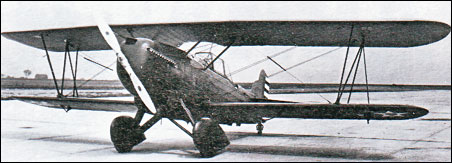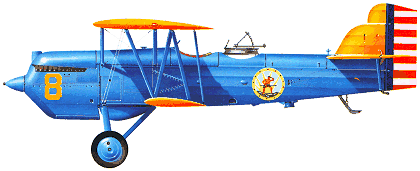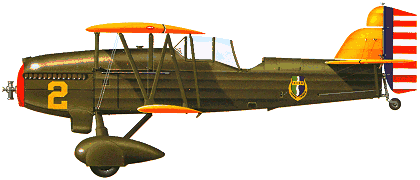 |
Curtiss O-1 / O-391925 |  |
| OBSERVATION BIPLANE | Virtual Aircraft Museum / USA / Curtiss |
 |
The first Curtiss biplane to bear the name Falcon was the Liberty-powered Curtiss L-113 (Model 37) which appeared in 1924. It was unsuccessful when evaluated as the XO-1 in competition with the Douglas XO-2 but was accepted for production the following year when re-engined with a 380kW Packard 1A-1500. It was a conventional unequal-span biplane with a wing of wooden construction that incorporated considerable sweep-back on the outer panels of the upper wing. The fuselage showed innovation, being built up from aluminium tubing with steel tie-rod bracing, and the tail unit included a balanced rudder; the sturdy fixed divided landing gear was of tailskid type. The new biplane went into production as the O-1 (Model 37A) for observation duties with the US Army. The initial order was for 10 aircraft re-engined with a Curtiss D-12. One of these was completed later as the O-1A with a Liberty engine, and the first O-1 was converted to O-1 Special configuration as a VIP transport. Forty-five examples of the O-1B (Model 37B) were ordered in 1927, this first major production version incorporating such refinements as wheel brakes and an underbelly auxiliary fuel tank which could be jettisoned in flight. They were followed by four O-1C aircraft, part of the O-1B order, converted to serve as VIP transports by enlargement of the rear cockpit and the addition of a baggage compartment. (The designation O-1D was not used). In 1929 the US Army ordered 41 of the O-1E (Model 37I) with V-1150E engines developed from the original Curtiss D-12. A number of other improvements included the introduction of oleo-pneumatic shock-absorbers and horn balanced elevators. One O-1E was modified subsequently as a VIP transport becoming redesignated O-1F (Model 37J). The XO-1G (Model 38) replacing the twin Lewis guns on a Scarff mounting that equipped the earlier models by a single gun on a post mounting. Other modifications introduced redesigned horizontal tail surfaces and a steerable tailwheel. The XO-1G was originally an O-1E which had been modified previously to contend as a new US Army basic trainer under the designation XBT-4 (Model 46). Successful tests led to construction of 30 series examples of the O-1G, bringing total O-1 production for the US Army to 127. The O-1 Falcon and its variants saw a decade of service with the observation squadrons of the US Army Air Corps and ended their days with reserve National Guard units. The basic design was adapted also as the A-3 attack biplane which saw considerable use. There were also export versions and a number of commercial Falcons. The basic design proved tough and workmanlike, but its dedication to a variety of less glamorous military and civil roles prevented it from achieving the renown of the contemporary Hawk fighter family.


|  COMPANY PROFILE | ||||||||||||||||||||||||||||||||||||||||||||||||||||||
 |

|
